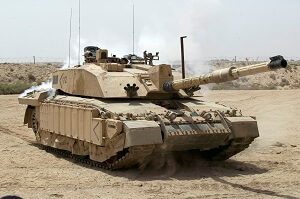Battle Tank Cost
Last Updated on February 1, 2024
Written by CPA Alec Pow | Content Reviewed by ![]() CFA Alexander Popinker
CFA Alexander Popinker
In the past, there were horse-drawn chariots. But then the tanks came to the battlefield, looking like biblical beasts with shells spitting fire and devastating everything in their path. They have changed the course of many wars.
This is an armored crawler fighting vehicle, designed primarily to engage enemy forces by direct fire. A tank is characterized by heavy weapons and armor, as well as a high degree of mobility that allows it to cross rugged terrain at relatively high speeds. Although tanks require expensive logistical support, they are among the most impressive and versatile weapons on the modern battlefield.
You might also like our articles about the cost of a fighter plane, a submarine, or a gyrocopter.
Many of those who drive supercars would easily afford a tank. Army-built machinery is available to civilians. But weapons are being removed and attack control and communication systems are being turned off. The future owner needs a Federal Destructive license to go out on a public road with a tank, and the tracks must be covered with rubber so as not to destroy the road.
But How Much Does A Battle Tank Cost?
Below you will find a list of the costs of some of the most common models of tanks. These are considered some of the best thanks to their high score protection, firepower, and mobility.
C1 Ariete Tank Cost
The price of a C1 Ariete tank is around $8 million. This was designed and produced in Italy in 1982 and has the capacity to carry 2500 mm rounds of 7.92 ammunition. Also, it has a standard 7.62 mm NATO machine gun and its weapon elevation and turret are controlled with manual backup.
M4 Sherman Tank Cost
Designed by the U.S. Army Artillery Department, the M4 Sherman was the most widely used tank by Americans in World War II. It was mobile, cheap to produce in large quantities, and distributed to the British and Soviets. It borrowed the mechanical model from the M3 tank but added the 75 mm cannon in a transverse turn and a gyrostabilizer that allowed it to shoot on the go, with a higher degree of accuracy.
It was in operation between 1942 and 1957 in the United States but is still used in other states. It was used in World War II, the civil wars in Korea, China, Greece, Lebanon, the Indo-Pakistani War, the Yom Kippur War. Between 1942 and 1945, 49,234 copies were produced. It weighed 30 to 38.1 tons, had a width of 2.62 to 2.99 meters, length of 5.84 to6.27 meters, height of 2.74 to 2.97 meters and armor of 12.7 mm.
The price of an M4Sherman tank is around $252,000.
Sd.Kfz. 251 Tank Cost
Sd.Kfz. 251 Tank is known also under the name of Sonderkraftfahrzeug 251 and costs around $3 million. This was designed to provide protection against small arms fire and to transport the Panzergrenadier into the battle field.
AMX – 56 Leclerc tank Cost
AMX – 56 Leclerc tank costs almost $30 million and was the main battle tank manufactured in 1992 by Nexter in France. It can reach a speed of 72 km/hour and has a 120 mm 52-caliber smoothbore cannon, which is capable of firing the same standard 120 mm NATO rounds. This model has a unique loading system specially designed to lower the number of crew members to three.
Tied – 7. Merkava IV Tank Cost
This tank costs almost $6 million and is characterized by artificial intelligence, virtual reality capabilities and up-to-date sensors. Also, it has a new Iron View helmet which lets the soldiers see what is happening outside the tank, while their activities are managed by an intelligent mission computer onboard the tank.
Merkava 4 battle tank has a V-12 powerful diesel engine with an output of 1,500 horsepower. Two fuel tanks are placed in the rear and one on the front of the tank. The engine of this model is 25% more powerful than the Merkava 3 model.
K2 Black Panther Tank Cost
K2 Black Panther tank was designed and produced in South Korea by the South Korean company Hyundai Rotem. The price of this model is almost $9 million. It has a 120mm/L55 Rheinmetall pistol produced in Germany, which is equipped with an automatic magazine that allows the loading of projectiles even while moving on rough terrain.
Centurion AVRE Tank Cost
 Manufactured in the United Kingdom since 1944 in over 4400 copies, it is not the best when it comes to maneuverability, but it has a reinforced armor of 17-152 mm. Production is also cheap. It reaches a speed of 35 km/h, with an operating radius of 80 km. It features a 105 mm Royal Ordnance L7 cannon and a Browning machine gun.
Manufactured in the United Kingdom since 1944 in over 4400 copies, it is not the best when it comes to maneuverability, but it has a reinforced armor of 17-152 mm. Production is also cheap. It reaches a speed of 35 km/h, with an operating radius of 80 km. It features a 105 mm Royal Ordnance L7 cannon and a Browning machine gun.
Centurion AVRE tank costs around $50,000.
FV4034 Challenger II Tank Cost
FV4034 Challenger II tank costs around $7.5 million and was designed and produced by the British company Vickers Defense System. This tank has the capacity to survive 14 hits from a rocket-propelled grenade and is equipped with a 77.62 mm L94A1 machine gun.
Leopard 2A6 Battle Tank Cost
The price of a Leopard 2A6 battle tank is around $7 million. This was manufactured for the first time in Germany in 1979. But Leopard 2 tanks are also produced internationally, through cooperation programs under the main responsibility of KMV.
It is still in service in countries such as Turkey, Canada, Spain, France, Sweden, Germany, Switzerland, Greece, Singapore, Norway, Portugal and Poland.
M1A2 SEP Tank Cost
The cost of the M1A2 SEP tank is almost $9 million and it is one of the best battle tanks in the world. It has incredible armor made of composites with graphite and depleted uranium. Also, this tank is equipped with a 120 mm pistol that has the capacity to fire with a high level of precision thanks to advanced optics and electronics.
Why does a battle tank cost so much?
A tank is not a simple vehicle in the classical sense of the term, but rather an armed system. While a tank incorporates devices of the latest technology, it reaches an excellent level through every traditional battlefield stat: mobility, protection, firepower.
Battle tanks are so expensive because they are made of strong materials such as steel, ceramic, plastic, and other classified materials. Also, there are metal alloys used like cobalt, molybdenum, tungsten, nickel, vanadium, boron, and manganese.


Leave a Reply
Want to join the discussion?Feel free to contribute!